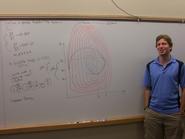
In the forest, populations of rabbits and foxes change relative to one another. Mathematicians model these population fluctuations using differential equations. But mathematical predator-prey models have limitations; for example, the models do not account for rabbits and foxes traversing different paths from water to food source. Combining differential equations and network optimization, Louis Boguchwal ’12 hopes to improve these standard models with guidance from Assistant Professor of Mathematics Andrew Dykstra.
Boguchwal describes his project as “network optimization with edge lengths governed by differential equations.” To understand this, pretend you are a rabbit who wants to get from your hole to a nearby pond. There is a network of potential paths you can take to get there. Some paths are better than others; after all, you want to avoid being eaten by a fox. And assuming you are traveling in a group, you also want to prevent your fellow rabbits from being eaten. But picking the optimal path is tricky, and will likely depend on several factors such as the time of day and the number of foxes living in the woods.
To find the best route, Boguchwal uses differential equations to model population changes. He is working to develop an algorithm that finds the optimal route in an accurate and efficient way. In addition to writing an algorithm that works on paper, he is also writing a computer program in the C++ language.
But creating an algorithm that encompasses so many changes is not easy. “You need to prove that the methods the algorithm is using at each step actually work,” Boguchwal said. In order to do this, he is “developing the mathematical machinery to address the problem”—this means deriving, proving, and testing the equations and methods that go into the algorithm. Boguchwal spends hours each day “performing phase portrait analysis.” A phase portrait is the graph of the solutions to a differential equation. For a predator-prey system, these solutions are loops. Just as the network contains paths, he finds the intersection points between the different loops to maximize the size of the final loop. In other words, graphic depiction allows Boguchwal to check and implement the algorithm he is creating.
If Boguchwal is successful in combining network optimization and differential equations, he sees many more applications beyond the predator-prey models. However, for the moment, he is still working out the kinks for predator-prey models, covering dry erase boards with large, concentric, and intersecting loops.
When he is not waiting for another burst of mathematical inspiration, Boguchwal enjoys long-distance running, Scottish country dancing and the outdoors. He founded HamilKorf, the korfball club at Hamilton, and is an active member of Hillel. He is pursuing a double major in mathematics and economics.
Boguchwal is a graduate of Fox Lane High School in Bedford, New York.
Boguchwal describes his project as “network optimization with edge lengths governed by differential equations.” To understand this, pretend you are a rabbit who wants to get from your hole to a nearby pond. There is a network of potential paths you can take to get there. Some paths are better than others; after all, you want to avoid being eaten by a fox. And assuming you are traveling in a group, you also want to prevent your fellow rabbits from being eaten. But picking the optimal path is tricky, and will likely depend on several factors such as the time of day and the number of foxes living in the woods.
To find the best route, Boguchwal uses differential equations to model population changes. He is working to develop an algorithm that finds the optimal route in an accurate and efficient way. In addition to writing an algorithm that works on paper, he is also writing a computer program in the C++ language.
But creating an algorithm that encompasses so many changes is not easy. “You need to prove that the methods the algorithm is using at each step actually work,” Boguchwal said. In order to do this, he is “developing the mathematical machinery to address the problem”—this means deriving, proving, and testing the equations and methods that go into the algorithm. Boguchwal spends hours each day “performing phase portrait analysis.” A phase portrait is the graph of the solutions to a differential equation. For a predator-prey system, these solutions are loops. Just as the network contains paths, he finds the intersection points between the different loops to maximize the size of the final loop. In other words, graphic depiction allows Boguchwal to check and implement the algorithm he is creating.
If Boguchwal is successful in combining network optimization and differential equations, he sees many more applications beyond the predator-prey models. However, for the moment, he is still working out the kinks for predator-prey models, covering dry erase boards with large, concentric, and intersecting loops.
When he is not waiting for another burst of mathematical inspiration, Boguchwal enjoys long-distance running, Scottish country dancing and the outdoors. He founded HamilKorf, the korfball club at Hamilton, and is an active member of Hillel. He is pursuing a double major in mathematics and economics.
Boguchwal is a graduate of Fox Lane High School in Bedford, New York.
